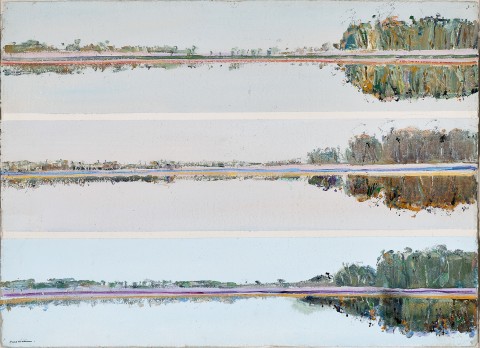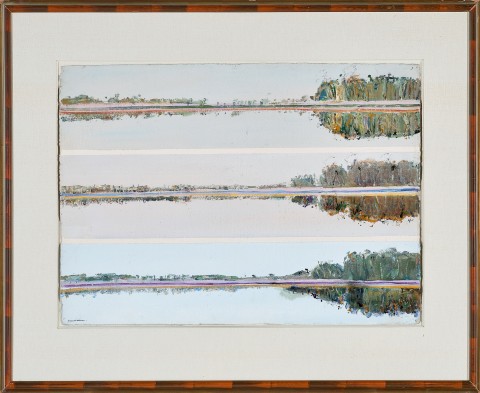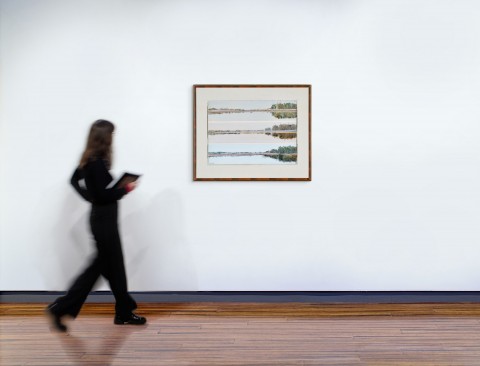EARLY MORNING RIVER REFLECTIONS, 1971
FRED WILLIAMS
gouache on paper
55.0 x 76.0 cm
signed lower left: Fred Williams
Vivienne Sharpe Fine Art, Sydney
Private collection, Perth
Rex Irwin Art Dealer, Sydney (label attached verso)
Corporate collection, Victoria
Sotheby's, Sydney, 7 May 2007, lot 112
Private collection, New South Wales
Fred Williams, Rex Irwin Art Dealer, Sydney, 26 May – 13 June 1987, cat. 7
Fred Williams’ contribution to the tradition of landscape painting in Australia can be counted among the most significant of the twentieth century. His painted and printed works, founded on physical interaction with the landscape, were formally inventive – creating a distinctive visual vocabulary that altered the collective perception of the country. Fascinated by the extreme variation of landscape views across the continent, Williams documented a distillation of its identifying features in situ, en plein air. Gouache, a quick-drying medium of watercolour mixed with a white pigment to render it opaque, was Williams’ primary medium for painting outdoors, also easily transportable back to the studio to inform larger works in oil.
At the close of the 1960s, Fred Williams felt the pressures of keeping up with contemporary trends in art making, writing in his diary in January 1971, ‘perhaps my most critical year’s work ever! – certainly, my work is at a stage where it needs only a slight push one way or another’.1 Indeed, Williams’ works of the 1970s radically changed. His oil paintings transformed under the influence of acrylic polymer paints, and an enthusiastic adoption of colour values never before used in his work, while the works on paper followed a new, ‘strip’, format ideal for depicting waterways and panoramic vistas. By masking off large portions of his standard-size sheet of watercolour paper, Williams could vary the dimensions of his gouaches to narrow his focus on an isolated motif of the landscape and its continuous relationship to the horizon. These strips were often multiplied into groups of two or three views of the same subject on one sheet, a repetition of theme and variation. Reinvigorated, Williams utilised this format extensively throughout the summer of 1970 – 71 to depict seascapes around Sorrento, Queenscliff and Waratah Bay.
This tripartite composition of a riverbank mirrored on the surface of the water, Early Morning River Reflections, 1971 is closely related to a painting, of synthetic polymer paint on composition board, titled Early Morning on the Murray River, 1971.2 Both works are said to have originated from polaroid photographs taken at a roadside rest point at Tocumwal, on the A39 highway between Melbourne and Brisbane in August of that year. Williams and his family had been travelling north, on their way to Springbrook, Albert Tucker’s property in South-East Queensland where they were to holiday for several weeks.3
Williams had been captivated by the crystalline stillness of the mighty Murray River, as it snaked its way through the Riverina on the border of Victoria and New South Wales. Red river gums bordering the Barmah National Park form the reflected motif highlighted in Williams’ cropped view. This scumbled grove of spindly tree trunks surges from the opposite bank of the river, darkly and imperfectly reflected in the water below. The three images are each bisected by a double horizon line in vibrant violet and orange paint, of varying intensity across the panels. The remaining low-lying vegetation of the riverbank is rendered fuzzily with a dry brush and swift strokes. This soft focus and lack of sharp detail surely mimic the resolution of the Polaroid photographs that Williams had taken as a record of the scene. Reflecting on a brief moment of early-morning calm during a long and noisy car trip up the coast, Williams produced a serene work that would later inform career-defining commissions such as the murals of the Murray River at Loxton produced in 1972 for the new Adelaide Festival Theatre.
1. Fred Williams Diary, 10 January 1971, cited in Mollison, J., A Singular Vision: The Art of Fred Williams, Australian National Gallery, Canberra, 1989, p. 152
2. Illustrated in Mollison, ibid., p. 154
3. See ibid. Indeed, it was at Tucker’s insistence that Williams first experimented with acrylic paint, which he diligently undertook throughout this holiday in 1971.
LUCIE REEVES-SMITH


